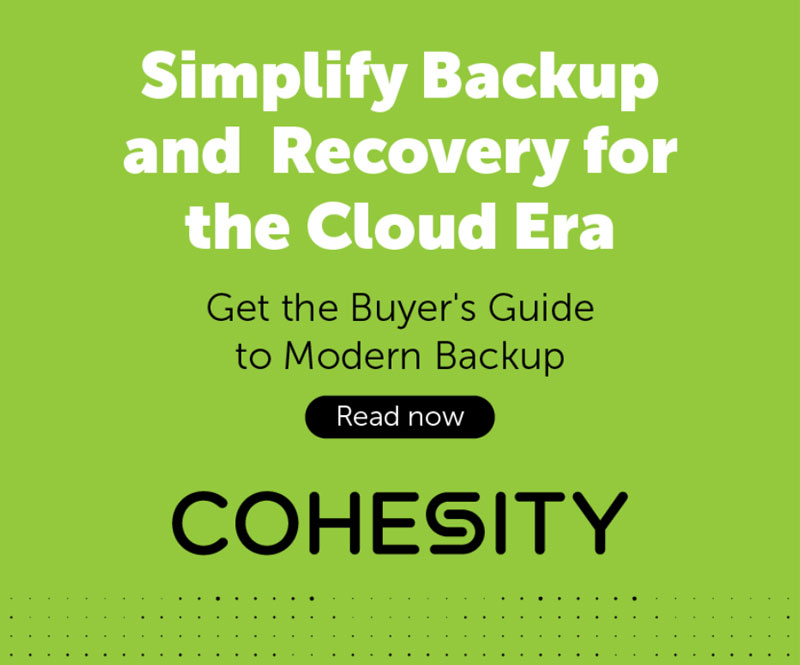As organizational needs change, and workloads become increasingly distributed, a key realization is emerging: traditional approaches to backup and recovery are no longer sufficient for most organizations. Companies have discovered that their existing tools are not keeping pace with other advancements in their IT environment.
Read on for help on your journey to finding the right backup and recovery solution.
Data Growth Challenges
Data silos
Today’s backup and recovery landscape is littered with separate legacy point-products for backups, target storage, and long-term data retention. It’s a complex environment to manage since each of these silos is designed on proprietary hardware and/or software packages that typically have their own management tools, upgrade cycles, and maintenance and support contracts.
Data deluge
At the same time, as cracks have begun to appear in the backup and recovery foundation, organizations are creating and consuming more data than ever before. As the saying goes, “data is the new currency” for enterprises, and it’s exploding all around us. Organizations across the globe are experiencing a data deluge, with the quantity of data increasing at an accelerating rate as new types of information are assimilated into existing data management systems.
No longer are companies storing only traditional routine business data. For some companies, the need to store human-generated data is paramount. But today, businesses are also absorbing data from a myriad of sensors and machines. And these devices are distributed across the enterprise.
Data sprawl
Another significant part of the data growth challenge revolves around supporting a far broader set of applications than in the past. And as cloud becomes an integral part of the overall IT ecosystem, modern applications and their data are residing both on-premises and in the cloud.
The point is that data growth is real and will continue, as the adoption of an ever-increasing number of applications shows. But, to paraphrase the old cliché, with great data comes great responsibility. Regardless of the source, enterprises need to keep pace with this data growth as they consider backup and recovery capabilities.
Legacy backup and recovery solutions
The reality, however, is that oftentimes customers are already at their limit and at best only able to perform backup jobs once a day, with such jobs sometimes bleeding into their “working hours” production windows. Perhaps even more importantly, should rapid recovery be necessary – say as the result of a ransomware attack – it can take multiple hours to restore, which has serious business implications. This is a recipe for IT tragedy should disaster strike.
Historically, organizations have invested significant portions of their IT budgets on backup and recovery tools, which they have accumulated over time. They continue to protect their data with legacy backup and recovery solutions that were designed for a different era of computing.
With some products having their origins tracing back decades, many such tools are simply unable to keep pace with modern business requirements and constant advancements. As business needs evolve, organizations must strive to stay ahead of growing IT complexities. Enterprises need IT infrastructure, including backup and recovery tools, that’s simple to manage, agile, and easy to scale.
Upgraded backup and recovery
If you’re considering an upgrade to your existing legacy backup and recovery capabilities, you’re far from alone. Gartner predicts that “… by 2021, 50% of organizations will augment or replace their current backup application with another solution, compared to what they deployed at the beginning of 2017.”
Choosing the right enterprise-grade, modern, web-scale backup and recovery solution involves understanding the full list of potential problems first, then comparing solutions to those problems.
How to choose a backup and recovery solution
Before you get started with a selection process for your next backup and recovery solution, it’s important to understand any potential shortcomings in your existing backup and recovery environment. The readiness assessment below outlines the 7 common backup and recovery challenges faced by IT. Take a few minutes to ask yourself these questions to help determine where to kick off your search.
1. Siloed infrastructure with multiple, fragmented UIs to configure backup workflows
Does your current solution require the use of backup software along with separate media servers, dedicated storage targets, and multiple user interfaces to create backup workflows? Do you need to operate separate environments for backing up physical workloads and another silo for virtual servers, and yet another product and console to help protect databases and applications?
2. Cloud gateways as intermediaries
If your current system provides any kind of support for the public cloud, does it require you to deploy separate bolt-on cloud gateways that act as intermediaries between your on-premises and public cloud-based backup and recovery environments?
3. Forklift upgrades and disruptive updates
When the time comes to grow your backup and recovery environment, do you need to rip-and-replace your existing infrastructure with a new one, which is expensive and complex? Do you need to schedule downtime to perform software updates?
4. Slow restores, last point in time only
Does your current solution suffer from performance problems at restore time, resulting in the potential for Recovery Time Objective (RTO) misses? Or does it just allow you to recover from only the latest backups made?
5. Variable and/or fixed block deduplication with compression
Does your current solution lack data deduplication features? Or, if it includes them, does it have restricted deduplication domains or fixed block deduplication capability only?
6. Disruptive, pre-planned upgrades
When a new software version becomes available for your current solution, do you need to go through a potentially disruptive process to adopt the new version? Or does the upgrade require a high level of planning?
7. Backup data cannot be reused; infrastructure remains siloed
Does your current solution provide only backup and recovery services? Does it allow you to reuse the data for other use cases such as DevTest? Does your current product allow you to increase efficiency by consolidating other workload storage environments?
Next steps
If you have one or more of the issues on this list, consider reviewing options for replacing your existing backup and recovery software. There are solutions on the market today that have rethought backup and recovery with a modern, web-scale point of view to address all these deficiencies in elegant, simple, and affordable ways.
How will you know what are the most important attributes to consider in a modern backup and recovery solution? Learn how to choose an enterprise backup and recovery solution with our checklist.

















